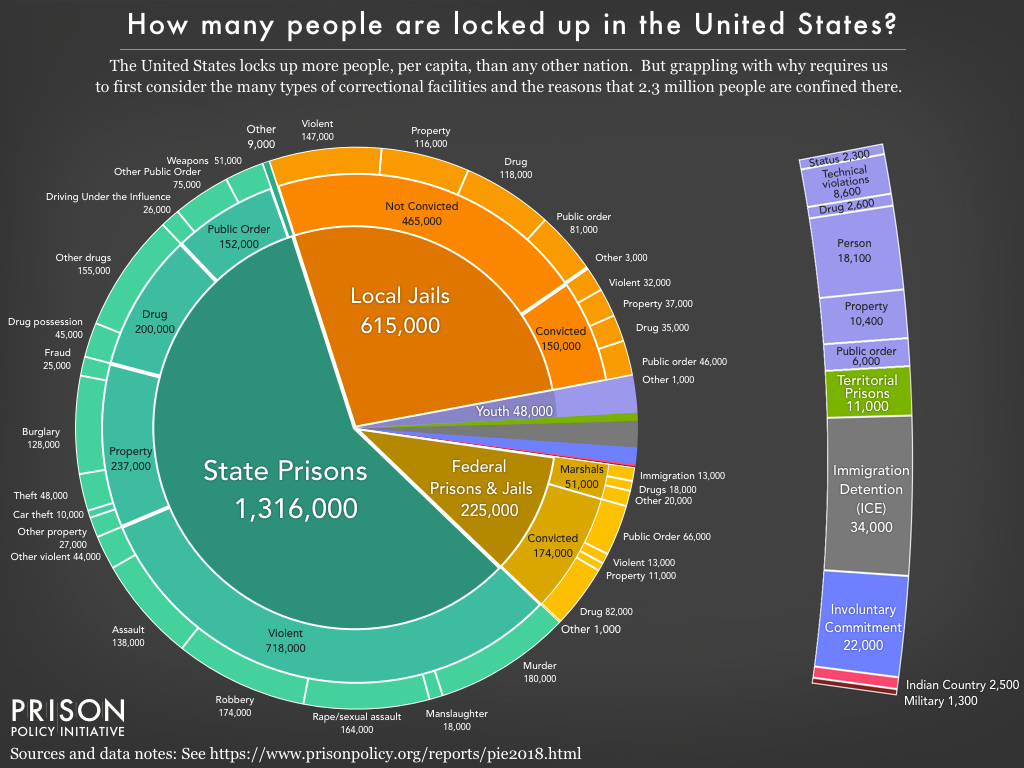New Report, Mass Incarceration: The Whole Pie 2018, pieces together systems of confinement and provides 11 new infographics
With this year's updated edition of Mass Incarceration: The Whole Pie, we once again answer the essential questions of how many people are locked up, where, and why.
March 14, 2018
Easthampton, Mass. – Are there 1.3 million people behind bars in the U.S., or is it actually closer to 2.3 million? How many millions more are on probation or parole, one mistake away from ending up back behind bars? The country’s fragmented systems of confinement make answering basic questions about mass incarceration unnecessarily difficult. With this year’s updated edition of Mass Incarceration: The Whole Pie, we once again answer the essential questions of how many people are locked up, where, and why.
 The first of 11 infographics that give the big picture and the details on who is behind bars, where, and why.
The first of 11 infographics that give the big picture and the details on who is behind bars, where, and why.
The publication of the new report caps a year-long effort to update the public on the major drivers of incarceration–state prisons and local jails–as well as confined populations too often overlooked, such as juveniles in residential placement and immigrants in detention.
“The big picture is important,” says author Peter Wagner, noting that many criminal justice reforms simply move people from one part of the system to another. “Ending mass incarceration means shrinking the size of the entire ‘pie,’ and not just rearranging where people are held within it.”
Key findings with important policy implications include:
- Jails admitted nearly 11 million people in 2016–enough to fill prison buses lined up end-to-end from New York to San Francisco.
- Half a million people are detained in jails before trial every day. In fact, most people in jails are not convicted, and many are there simply because they can’t afford money bail.
- The vast number of people incarcerated for low-level offenses include nearly 9,000 youth confined for “technical violations” of probation.
- 2,300 more youth are locked up for “status” offenses that are not even criminal violations for adults, such as running away or skipping school.
This edition of Mass Incarceration: The Whole Pie includes more parts of the system than previous versions of the graphic, not because mass incarceration has expanded, but because we’ve developed a way to offer a more comprehensive view. “We spent the last year collecting data about institutions that may not consider themselves a part of mass incarceration, yet confine thousands of justice-involved people,” said co-author Wendy Sawyer. This update to the report includes more juvenile facilities, adds state psychiatric hospitals, and offers more detailed data on federal corrections.
The United States locks up more people than any other country, at a rate more than five times higher than most other nations. One impediment to reform is the lack of available data to guide that conversation. In Whole Pie, the Prison Policy Initiative provides the comprehensive view of mass incarceration that society needs in order to plot a path forward.
Mass Incarceration: The Whole Pie is one in a series of reports that provide equally comprehensive snapshots of women’s incarceration and youth confinement. Previous national reports from the Prison Policy Initiative include Following the Money of Mass Incarceration, which uses economic data to show who pays for and who benefits from mass incarceration, and Detaining the Poor: How money bail perpetuates an endless cycle of poverty and jail time, which finds that the ability to pay money bail is impossible for many defendants because it represents eight months of a typical defendant’s income.
The non-profit, non-partisan Prison Policy Initiative was founded in 2001 to expose the broader harm of mass criminalization and spark advocacy campaigns to create a more just society. The organization leads the nation’s fight to keep the prison system from exerting undue influence on the political process (via prison gerrymandering) and plays a leading role in protecting the families of incarcerated people from the predatory prison and jail telephone industry and the video visitation industry.
The full report and graphics are available at https://www.prisonpolicy.org/reports/pie2018.html.
-30-



